|
|
|
Sexual ConflictGoran Arnqvist and Locke Rowe
Monographs in Behavior and Ecology
Princeton University Press
2005
"The past decade has seen a profound change in the scientific understanding of reproduction. The traditional view of reproduction as a joint venture undertaken by two individuals, aimed at replicating their common genome, is being challenged by a growing body of evidence showing that the evolutionary interests of interacting males and females diverge. This book demonstrates that, despite a shared genome, conflicts between interacting males and females are ubiquitous, and that selection in the two sexes is continuously pulling this genome in opposite directions. These conflicts drive the evolution of a great variety of those traits that distinguish the sexes and also contribute to the diversification of lineages. Göran Arnqvist and Locke Rowe present an array of evidence for sexual conflict throughout nature, and they set these conflicts into the well-established theoretical framework of sexual selection. The recognition of conflict between the sexes is transforming our theories for the evolution of mating systems and the sexes themselves. Written by two top researchers in the field, Sexual Conflict is the first book to describe this transformation. It is a must read for all scholars and students interested in the evolutionary biology of reproduction."
|
Buy from amazon.co.uk 
|
|
The Evolution of Animal Communication: Reliability and Deception in Signaling SystemsWilliam A Searcy and Stephen Nowicki
Monographs in Behavior and Ecology
Princeton University Press
2005
"Gull chicks beg for food from their parents. Peacocks spread their tails to attract potential mates. Meerkats alert family members of the approach of predators. But are these - and other animals - sometimes dishonest? That's what William Searcy and Stephen Nowicki ask in The Evolution of Animal Communication. They take on the fascinating yet perplexing question of the dependability of animal signaling systems. The book probes such phenomena as the begging of nesting birds, alarm calls in squirrels and primates, carotenoid coloration in fish and birds, the calls of frogs and toads, and weapon displays in crustaceans. Do these signals convey accurate information about the signaler, its future behavior, or its environment? Or do they mislead receivers in a way that benefits the signaler? For example, is the begging chick really hungry as its cries indicate or is it lobbying to get more food than its brothers and sisters? Searcy and Nowicki take on these and other questions by developing clear definitions of key issues, by reviewing the most relevant empirical data and game theory models available, and by asking how well theory matches data. They find that animal communication is largely reliable - but that this basic reliability also allows the clever deceiver to flourish. Well researched and clearly written, their book provides new insight into animal communication, behavior, and evolution."
|
Buy from amazon.co.uk 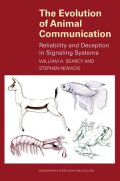
|
|
Hormones and Animal Social BehaviorElizabeth Adkins-Regan
Monographs in Behavior and Ecology
Princeton University Press
2005
"Research into the lives of animals in their natural environments has revealed a rich tapestry of complex social relationships and previously unsuspected social and mating systems. The evolution of this behavior is increasingly well understood. At the same time, laboratory scientists have made significant discoveries about how steroid and peptide hormones act on the nervous system to shape behavior. An exciting and rapidly progressing hybrid zone has developed in which these two fields are integrated, providing a fuller understanding of social behavior and the adaptive functions of hormones. This book is a guide to these fascinating connections between animal social behavior and steroid and peptide hormones - a synthesis designed to make it easier for graduate students and researchers to appreciate the excitement, engage in such integrative thinking, and understand the primary literature. Throughout, Elizabeth Adkins-Regan emphasizes concepts and principles, hypothesis testing, and critical thinking. She raises unanswered questions, providing an unparalleled source of ideas for future research. The chapter sequence is by levels of biological organization, beginning with the behavior and hormones of individuals, proceeding to social relationships and systems, and from there to development, behavioral evolution over relatively short time scales, life histories and their evolution, and finally evolution over longer time scales. The book features studies of a wide variety of wild and domestic vertebrates along with some of the most important invertebrate discoveries."
|
Buy from amazon.co.uk 
|
|
Neural Networks and Animal BehaviorMagnus Enquist and Stefano Ghirlanda
Monographs in Behavior and Ecology
Princeton University Press
2005
"How can we make better sense of animal behavior by using what we know about the brain? This is the first book that attempts to answer this important question by applying neural network theory. Scientists create Artificial Neural Networks (ANNs) to make models of the brain. These networks mimic the architecture of a nervous system by connecting elementary neuron-like units into networks in which they stimulate or inhibit each other's activity in much the same way neurons do. This book shows how scientists can employ ANNs to analyze animal behavior, explore the general principles of the nervous systems, and test potential generalizations among species. The authors focus on simple neural networks to show how ANNs can be investigated by math and by computers. They demonstrate intuitive concepts that make the operation of neural networks more accessible to nonspecialists. The first chapter introduces various approaches to animal behavior and provides an informal introduction to neural networks, their history, and their potential advantages. The second chapter reviews artificial neural networks, including biological foundations, techniques, and applications. The following three chapters apply neural networks to such topics as learning and development, classical instrumental condition, and the role of genes in building brain networks. The book concludes by comparing neural networks to other approaches."
|
Buy from amazon.co.uk 
|
|
Mating Systems and StrategiesStephen M. Shuster and Michael J. Wade
Monographs in Behavior and Ecology
Princeton University Press
2005
"This book presents the first unified conceptual and statistical framework for understanding the evolution of reproductive strategies. Using the concept of the opportunity for sexual selection, the authors illustrate how and why sexual selection, though restricted to one sex and opposed in the other, is one of the strongest and fastest of all evolutionary forces. They offer a statistical framework for studying mating system evolution and apply it to patterns of alternative mating strategies. In doing so, they provide a method for quantifying how the strength of sexual selection is affected by the ecological and life history processes that influence females' spatial and temporal clustering and reproductive schedules. Directly challenging verbal evolutionary models that attempt to explain reproductive behavior without quantitative reference to evolutionary genetics, this book establishes a more solid theoretical foundation for the field. Among the weaknesses the authors find in the existing data is the apparent ubiquity of condition-dependent mating tactics. They identify factors likely to contribute to the evolution of alternative mating strategies - which they argue are more common than generally believed - and illustrate how to measure the strength of selection acting on them. Lastly, they offer predictions on the covariation of mating systems and strategies, consider the underlying developmental biology behind male polyphenism, and propose directions for future research."
|
Buy from amazon.co.uk 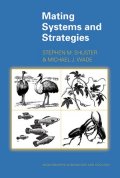
|
|
The African Wild Dog: Behaviour, Ecology and ConservationScott Creel and Nancy Creel
Monographs in Behavior and Ecology
Princeton University Press
2002
"The book emphasizes ecology, concentrating on why wild dogs fare poorly in protected areas that maintain healthy populations of lions, hyenas, or other top carnivores. In addition to conservation issues, it covers fascinating aspects of wild dog behavior and social evolution. The Creels use demographic, behavioral, endocrine, and genetic approaches to examine how and why nonbreeding pack mates help breeding pairs raise their litters. They also present the largest data set ever collected on mammalian predator-prey interactions and the evolution of cooperative hunting, allowing them to account for wild dogs' prowess as hunters."
|
Buy from amazon.co.uk 
|
|
Model Systems in Behavioural Ecology: Integrating Conceptual, Theoretical, and Empirical ApproachesEditor: Lee Alan Dugatin
Monographs in Behavior and Ecology
Princeton University Press
2001
"A key way that behavioral ecologists develop general theories of animal behavior is by studying one species or a closely related group of species -model systems- over a long period. This book brings together some of the field's most respected researchers to describe why they chose their systems, how they integrate theoretical, conceptual, and empirical work, lessons for the practice of the discipline, and potential avenues of future research. Their model systems encompass a wide range of animals and behavioral issues, from dung flies to sticklebacks, dolphins to African wild dogs, from foraging to aggression, territoriality to reproductive suppression. Model Systems in Behavioral Ecology offers an unprecedented 'systems' focus and revealing insights into the confluence of personal curiosity and scientific inquiry. It will be an invaluable text for behavioral ecology courses and a helpful overview - and a preview of coming developments - for advanced researchers. The twenty-five chapters are divided into four sections: insects and arachnids, amphibians and reptiles, birds, and mammals."
|
Buy from amazon.co.uk 
|
|
Sperm Competition and its Evolutionary Consequences in the InsectsLeigh W. Simmons
Monographs in Behavior and Ecology
Princeton University Press
2001
"This book analyzes and extends thirty years of theoretical and empirical work on insect sperm competition. It considers both male and female interests in sperm utilization and the sexual conflict that can arise when these differ. It covers the mechanics of sperm transfer and utilization, morphology, physiology, and behavior. Sperm competition is shown to have dramatic effects on adaptation in the context of reproduction as well as far-reaching ramifications on life-history evolution and speciation."
|
Buy from amazon.co.uk 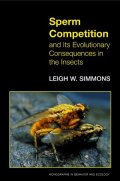
|
|
Social Foraging TheoryLuc-Alain Giraldeau and Thomas Caraco
Monographs in Behavior and Ecology
Princeton University Press
2000
"Although there is extensive literature in the field of behavioral ecology that attempts to explain foraging of individuals, social foraging - the ways in which animals search and compete for food in groups - has been relatively neglected. This book redresses that situation by providing both a synthesis of the existing literature and a new theory of social foraging. Giraldeau and Caraco develop models informed by game theory that offer a new framework for analysis. Social Foraging Theory contains the most comprehensive theoretical approach to its subject, coupled with quantitative methods that will underpin future work in the field. The new models and approaches that are outlined here will encourage new research directions and applications."
|
Buy from amazon.co.uk 
|
|
Levels of Selection in EvolutionEditor: Laurent Keller
Monographs in Behavior and Ecology
Princeton University Press
1999
"Recent studies show that at many levels of biological organization, mechanisms have evolved to prevent potential conflict in natural selection. Editor Laurent Keller's aim in this book is to bring together leading researchers from all biological disciplines to outline these potential conflicts and discuss how they are resolved. A multi-level approach of this kind allows important insights into the evolution of life, as well as bridging the long-standing conceptual chasm between molecular and organismal biologists. The chapters here follow a rigorous theoretical framework, giving the book an overall synergy that is unique to multi-authored books."
|
Buy from amazon.co.uk 
|
|
Foundations of Social EvolutionSteven A Frank
Monographs in Behavior and Ecology
Princeton University Press
1999
"This is a masterly theoretical treatment of one of the central problems in evolutionary biology, the evolution of social cooperation and conflict. Steven Frank tackles the problem with a highly original combination of approaches: game theory, classical models of natural selection, quantitative genetics, and kin selection. He unites these with the best of economic thought: a clear theory of model formation and comparative statics, the development of simple methods for analyzing complex problems, and notions of information and rationality. Using this unique, multidisciplinary approach, Frank makes major advances in understanding the foundations of social evolution."
|
Buy from amazon.co.uk 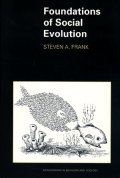
|
|
Parasites in Social InsectsPaul Schmid-Hempel
Monographs in Behavior and Ecology
Princeton University Press
1998
"This book analyzes for the first time how parasites shape the biology of social insects: the ants, wasps, bees, and termites. Paul Schmid-Hempel provides an overview of the existing knowledge of parasites in social insects. Current ideas are evaluated using a broad database, and the role of parasites for the evolution and maintenance of the social organization and biology of insects is carefully scrutinized. In addition, the author develops new insights, especially in his examination of the intricate relationships between parasites and their social hosts through the rigorous use of evolutionary and ecological concepts."
|
Buy from amazon.co.uk 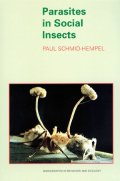
|
|
Sex, Color, and Mate Choice in GuppiesAnne E. Houde
Monographs in Behavior and Ecology
Princeton University Press
1997
"The Trinidadian guppy (Poecilia reticulata) is well known to biologists and home aquarium enthusiasts alike. Scientists have studied guppies for most of the twentieth century. Some of the most intensive recent research has been conducted by behavioral ecologists, who have found that the guppy mating system makes guppies especially useful in the study of sexual selection and mate choice. By observing guppy behavior in aquaria, researchers hope to obtain new insights into how selection operates in natural populations. Here Anne Houde summarizes and synthesizes the scientific work done to date, relates the empirical findings on guppies to current themes in sexual selection theory, and suggests new directions for future research."
|
Buy from amazon.co.uk 
|
|
Female Control: Sexual Selection by Cryptic Female ChoiceWilliam G. Eberhard
Monographs in Behavior and Ecology
Princeton University Press
1996
"A growing body of evidence has begun to reveal flaws in the traditional assumption of female passivity and lack of discrimination after copulation has begun. William Eberhard has compiled an impressive array of research on the ability of females to shape the outcome of mating. He describes studies of many different cryptic mechanisms by which a female can accept a male for copulation but nevertheless reject him as a father. Evidence from various fields indicates that such selectivity by females may be the norm rather than the exception. Because most post-copulatory competition between males for paternity is played out within the bodies of females, female behavior, morphology, and physiology probably often influence male success in these contests. Eberhard draws examples from a diversity of organisms, ranging from ctenophores to scorpions, nematodes to frogs, and crickets to humans."
|
Buy from amazon.co.uk 
|
|
Social Evolution in AntsAndrew F. G. Bourke and Nigel R. Franks
Monographs in Behavior and Ecology
Princeton University Press
1996
"Biologists since Darwin have been intrigued and confounded by the complex issues involved in the evolution and ecology of the social behavior of insects. The self-sacrifice of sterile workers in ant colonies has been particularly difficult for evolutionary biologists to explain. In this important new book, Andrew Bourke and Nigel Franks not only present a detailed overview of the current state of scientific knowledge about social evolution in ants, but also show how studies on ants have contributed to an understanding of many fundamental topics in behavioral ecology and evolutionary biology."
|
Buy from amazon.co.uk 
|
|
LeksJacob Höglund and Rauno V. Alatalo
Monographs in Behavior and Ecology
Princeton University Press
1995
"The evolution of leks -clusters of small territories where males congregate and display in order to attract mates- is of central issue in behavioral ecology, because of the insights it offers into female mate choice, sexual selection, and the evolution of mating systems. In the first book on the subject, Jacob Höglund and Rauno Alatalo draw together existing knowledge on two main aspects of lekking. Why do leks evolve in some species and not in others? Why do females of certain lekking species select their mates even though such behavior reaps few or no material benefits for them? In each case they emphasize the importance of understanding the selective forces that act on individuals in natural populations."
|
Buy from amazon.co.uk 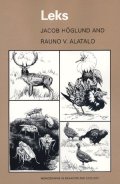
|
|
Polygyny and Sexual Selection in Red-Winged BlackbirdsWilliam A. Searcy and Ken Yasukawa
Monographs in Behavior and Ecology
Princeton University Press
1995
"The aim of this text is to explain why red-winged blackbirds are polygynous and to describe the effects of this mating system on other aspects of the biology of the species. Polygyny, the study shows, has the effect of intensifying sexual selection by increasing the variance in mating success."
|
Buy from amazon.co.uk 
|
|
Sexual SelectionMalte Andersson
Monographs in Behavior and Ecology
Princeton University Press
1994
"Bright colors, enlarged fins, feather plumes, song, horns, antlers, and tusks are often highly sex dimorphic. Why have males in many animals evolved more conspicuous ornaments, signals, and weapons than females? How can such traits evolve although they may reduce male survival? Such questions prompted Darwin's perhaps most scientifically controversial idea - the theory of sexual selection. It still challenges researchers today as they try to understand how competition for mates can favor the variety of sex-dimorphic traits. Reviewing theoretical and empirical work in this very active field, Malte Andersson, a leading contributor himself, provides a major up-to-date synthesis of sexual selection."
|
Buy from amazon.co.uk 
|
|
Parasitoids: Behavioral and Evolutionary EcologyH.C.J. Godfray
Monographs in Behavior and Ecology
Princeton University Press
1993
"Parasitoids lay their eggs on or in the bodies of other species of insect, and the parasitoid larvae develop by feeding on the host, causing its eventual death. Known for a long time to applied biologists for their importance in regulating the population densities of economic pests, parasitoids have recently proven to be valuable tools in testing many aspects of evolutionary theory. This book synthesizes the work of both schools of parasitoid biology and asks how a consideration of evolutionary biology can help us understand the behavior, ecology, and diversity of the approximately one to two million species of parasitoid found on earth."
|
Buy from amazon.co.uk 
|
|
The Ostrich Communal Nesting SystemBrian C.R. Bertram
Monographs in Behavior and Ecology
Princeton University Press
1992
"As the study of co-operative breeding systems expands, a number of key species form the examples that underpin our general understanding. The ostrich is increasingly becoming such a textbook species, on the basis of the results obtained in Brian Bertram's study of vigilance and egg discrimination in this bird. Here, Bertram presents new data on the ostrich communal nesting system, in which several females lay in one female's nest, with only one female and the male doing all the work. His study unravels the basis of the co-operation observed, and explains how a system involving apparent altruism is maintained by natural selection. It is now possible as never before to explain and quantify the effects of the different choices these birds make and to integrate ecological and morphological factors such as predation and size. Based on three seasons of study in Tsavo West National Park in Kenya, the author recognizes individual birds, detects and monitors well-concealed nests, determines the motherhood of eggs from their surface appearance, and uses time-lapse photography of nests. Key findings are that females can switch rapidly between reproductive strategies, that a nesting female can recognize her own eggs and when necessary discriminate against those of other females, and that the whiteness of ostrich eggs is an adaptation that protects them against overheating but at the cost of greater vulnerability to predation."
|
Buy from amazon.co.uk 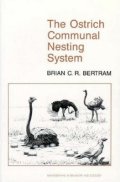
|
|
The Evolution of Parental CareT.H. Clutton-Brock
Monographs in Behavior and Ecology
Princeton University Press
1991
"Synthesizing studies of parental care in a wide variety of animals, this book is the first attempt to provide general answers to the following important questions: Why does the extent of parental care vary so widely between species? Why do only females care for eggs and young in some animals, only males in others, and both parents in a few? To what extent is parental care adjusted to variation in its benefits to offspring and its costs to parents? How do parents divide their resources between their sons and daughters? In this book separate chapters examine the evolution of variation in egg and neonate size, of viviparity and other forms of bearing, and of differences in the duration of incubation, gestation, and lactation. The book reviews theoretical and empirical predictions concerning the evolution of parental care and examines the extent to which these are supported by empirical evidence."
|
Buy from amazon.co.uk 
|
|
The Biology of the Naked Mole-RatEditor: Paul W. Sherman, Jennifer U.M. Jarvis and Richard D. Alexander
Monographs in Behavior and Ecology
Princeton University Press
1991
"This volume brings together more than a decade of information collected in the field and lab on the naked mole-rat (Heterocephalus glaber), a northeast African mammal unique for its physical characteristics and eusociality. Nearly blind and virtually hairless, naked mole-rats inhabit large subterranean colonies in which only one female and her one to three mates conceive offspring, while the young from previous litters maintain and defend the group as do workers in colonies of the social insects. In this first major treatise on naked mole-rats an international group of researchers covers such topics as the evolution of eusociality, phylogeny and systematics of the rodent family Bathyergidae, population and behavioral ecology and genetics of naked mole-rats in the field, vocal and nonvocal behaviors, social organization and divisions of labor within colonies, and climatic, social, and physiological factors affecting growth, reproduction, and reproductive suppression."
|
Buy from amazon.co.uk 
|
|
Dynamic Modeling in Behavioral EcologyMarc Mangel and Colin Whitcomb Clark
Monographs in Behavior and Ecology
Princeton University Press
1989
"This book describes a powerful and flexible technique for the modeling of behavior, based on evolutionary principles. The technique employs stochastic dynamic programming and permits the analysis of behavioral adaptations wherein organisms respond to changes in their environment and in their own current physiological state. Models can be constructed to reflect sequential decisions concerned simultaneously with foraging, reproduction, predator avoidance, and other activities."
|
Buy from amazon.co.uk 
|
|
Helping And Communal Breeding in Birds: Ecology and EvolutionJerram L. Brown
Monographs in Behavior and Ecology
Princeton University Press
1987
|
Buy from amazon.co.uk 
|
|
Foraging TheoryDavid W. Stephens and John R. Krebs
Monographs in Behavior and Ecology
Princeton University Press
1986
|
Buy from amazon.co.uk 
|
|